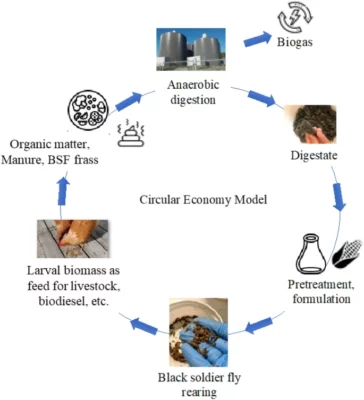
Squaring a Circle
Black soldier flies can be a great component in a circular economy, in more than one way. However, they cannot always perform miracles. For example, they cannot feed on biogas digestate (which is a fancy term to describe leftovers of processing waste into biogas). While this is sad, it is also not very surprising because gas-producing bacteria were likely to remove a considerable proportion of nutrients from the substrate. In addition, they may have poisoned it with their own metabolites.
Brodeur, D., Deschamps, M.H., Vandenberg, G., Barnabé, S., Gómez, D., Déry, M.A., Vaneeckhaute, C. and Adjalle, K., 2023. Integration of Pretreated Crop Residues to Improve the Valorization of Biogas Digestate by the Black Soldier Fly (Hermetia illucens L.; Diptera: Stratiomyidae) Larvae. Waste and Biomass Valorization, https://doi.org/10.1007/s12649-023-02340-z
The growing interest in anaerobic digestion has led to an increase in the production of digestate that can be re-used. This work evaluates the possibility of using black soldier fly larvae (BSFL) to valorize biogas digestate, maize residue and alfalfa. The solid fraction of two digestates originating from two different biogas plants was used. Different diets (mixed or single substrates) were developed using digestate, maize residue and alfalfa. In addition, thermal hydrolysis as well as enzymatic hydrolysis were performed on the agricultural crops to break down fibers into reducing sugars, before being fed to BSFL. Chemical analysis of the substrates and a performance analysis were conducted. Application of the pretreatment on the agricultural crops improved larval growth on maize residue and alfalfa. Although larvae reached higher mass gain on pretreated maize residue and alfalfa than on non-pretreated crops, once these agricultural crops were mixed with digestate, performance decreased. Indeed, larval growth on digestate-based diets was very poor compared to the standard diet, with the average individual larval weight reared on digestate 1 and digestate 2 being 14.6 ± 2.54 mg and 46.43 ± 6.68 mg, respectively. A significant difference (p = 0.0018) was found between length gain of the two digestates, indicating that certain digestates lead to different BSFL yield. According to the results of this study, BSFL treatment of digestate was not efficient and further research is needed to elucidate the mechanisms preventing digestate from being effectively converted into larval biomass.
